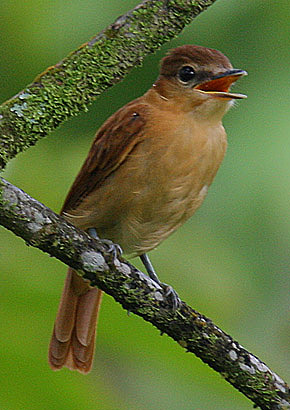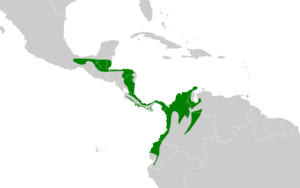Cinnamon becard facts for kids
Quick facts for kids Cinnamon becard |
|
|---|---|
 |
|
| On the slopes of the Arenal Volcano, Costa Rica | |
| Conservation status | |
| Scientific classification | |
| Genus: |
Pachyramphus
|
| Species: |
cinnamomeus
|
 |
|
The cinnamon becard (Pachyramphus cinnamomeus) is a cool passerine bird found in parts of Central and South America. It's known for its pretty cinnamon-colored feathers. This bird is a type of "perching bird," like many songbirds you might see!
Contents
About the Cinnamon Becard
How Scientists Group Birds
Scientists like to group animals based on how they are related. This is called taxonomy. The cinnamon becard has been a bit tricky to place. Some experts thought it belonged with birds like the tityras, in either the cotinga or tyrant flycatcher families.
However, new information suggests that tityras and their close relatives should be in their own special family called Tityridae. The AOU, a group of bird experts, agrees with this idea.
What Does It Look Like?
The adult cinnamon becard is about 5.5 inches (14 cm) long. That's about the length of a typical pencil! It weighs between 0.6 and 0.8 ounces (17–22 grams), which is very light.
This bird is a reddish-brown color on its back, which is called rufous. Its belly is a lighter cinnamon color. It has a grey beak and grey legs. Unlike many other becard birds, the male and female cinnamon becards look very similar. Young birds are a bit brighter on top and lighter all over.
Birds living in the northern parts of their range have a pale stripe above their eye. They also have a dark line from their beak to their eye. However, a special type of cinnamon becard, called Pachyramphus cinnamomeus magdalenae, lives west of the Andes mountains. These birds have a stronger stripe above their eye and a darker line near their beak.
What Does It Sound Like?
Cinnamon becards make high, thin whistling sounds. The male birds sing a sad-sounding song that goes up in pitch, like "dee dee dee dee dee dee de." The female's song is softer, sounding like "deeeu dew dew, dew dew."
Where Do Cinnamon Becards Live?
Distribution and Habitat
The cinnamon becard lives in many places. You can find it from southeastern Mexico all the way south to northwestern Ecuador and northwestern Venezuela. Recently, scientists found that it's much more common than they thought on the Amazonian side of the Colombian Cordillera Oriental mountains.
These birds can live at many different heights, from almost sea level up to more than 5,000 feet (1,700 meters) ASL. They like places where the natural environment has been changed a bit. This includes open woodlands, forest edges, and clearings. They also enjoy living in mangrove forests and secondary forests. Secondary forests are places where trees have grown back after being cut down. For example, they like areas with Naked Albizia trees.
Cinnamon Becard Life Cycle
Reproduction and Nesting
The female cinnamon becard builds the nest all by herself. She makes a round nest out of plant materials. It has a small opening and is usually built at the very tip of a high tree branch. These nests are often found 8 to 50 feet (2.5–15 meters) up in the air.
For extra protection, the nest is often built close to a wasp nest! The wasps help keep predators away. The female usually lays 3 to 4 eggs. These eggs are brownish-white with olive-brown spots. She lays them between March and July. The female sits on the eggs for 18 to 20 days until they hatch. After the chicks hatch, the male bird helps feed them.
What Do They Eat?
Cinnamon becards are good at catching food while flying. They pick up large insects and spiders right off the leaves of plants. They also often hover in the air to grab small berries to eat.


